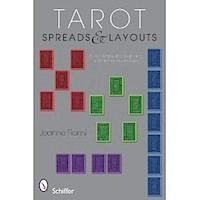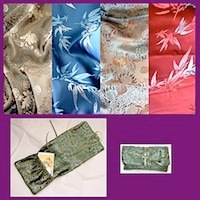By Jeanne Fiorini
OK -- fess up: How many of you own more than 10 Tarot decks? More than 20? Do I hear 50?
I know you’re out there. I wonder if any of the Tarot bloggers have taken a poll to find out who holds the record for having the most Tarot decks. There’s certainly no question that once you get the Tarot bug, it’s pretty darned hard to keep your inventory low.
I own comparatively few Tarot decks, probably 15 or so, and use only 4 or 5 of them on a regular basis. Among the decks I do own are several which I value and appreciate and are good to have on hand, but with which I don’t do readings; they’re just not my style, whatever that means.
Aside from the numerous other reasons to collect Tarot decks, the “compare and contrast” exercise that accompanies the exploration of a new deck can be a richly-rewarding, mind-expanding experience, prompting questions such as:
- How do different authors interpret the various points along Major Arcana?
- What is the world-view being expressed by a particular deck?
- How are the suits defined and how do they relate to one another?
- What is the style, coloring, and general tone of the deck?
- Which images stand out to you?
- Which cards speak to you in new and interesting ways?
- Does the deck bring with it a fresh perspective?
- Does the deck as a whole resonate with you, your intuition, and your sensibilities?
With this kind of thoughtful processing, our personal storehouse of images and meanings for the 78-piece puzzle that is Tarot increases. Each time we familiarize ourselves with a new Tarot deck, the added images become part of our individual database for interpretation. It’s as if there is a slide library in our mind’s eye-- our own “private collection” of images-- with an unlimited number of possible entries for each slot in the catalogue.
But if the purpose of a new deck is to bring something unique to the Tarot table, what does this mean about the prospects of getting a clear message from the cards? What happens to the other pieces in our private collection when there’s a new entry? As if we needed yet another variable in the already-tricky art of reading Tarot, thank you very much.
Here’s the bullet point, a rule of thumb for maintaining sanity in the face of a multitude of known interpretations for any one card: Keep an awareness of the known possibilities, but work with the deck that’s in front of you.
Work with the deck-- the pictures, the colors, the impressions, the information -- that is in front of you. “Love the one you’re with” so to speak, and don’t get sidetracked by thoughts about what a card might mean in another deck.
In any given reading, one particular deck is being utilized for some reason, whether that reason is consciously-driven or not. Once you’ve chosen a deck to work with, there’s a responsibility to give first voice to the images and world-view therein. “To thine own Tarot deck be true”… even if you choose to build your interpretations from there.
My current go-to decks, the ones that are used regularly with clients, are the original version of the Rider-Waite Tarot, the Morgan-Greer Tarot deck, Kat Black’s Golden Tarot, and the Mythic Tarot. Each set of cards has a distinctive voice and character which separates it from the others.
Similarly to the way that Tarot decks have differing energies, clients bring differing energies to the reading process. (Another dang variable!) To cover as many bases as possible, I like to know that the deck I’m using with a particular client can speak to their unique perspective through its unique perspective.
Accordingly, prior to every reading, I “ask” my decks if they’d like to speak with so-and-so today. I do this by cutting each deck a few times to see which ones might be jumping up screaming “Pick me, pick me!” and which ones are retreating as if to say “Keep me out of this.”
It’s very interesting to make note, as a reading unfolds, how the particular nuances of a specific deck come to be relevant in the context of a session; how certain cards, had they come from another version of the Tarot, wouldn’t have conveyed the same message as did occur with the chosen deck. Here are some examples from actual readings to make the point:
1. From the Golden Tarot:
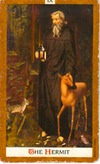
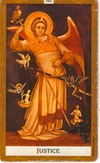
A person with what I later learned was an established spiritual connection to the figure of St. Francis draws The Hermit card as the reading’s final “guiding card,” here depicted as St. Francis.
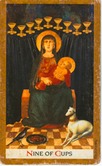
A person struggling to find their equilibrium when dealing with other members of the family draws the Justice card. In an image significantly contrary to many other decks, we see The Angels (and Athena) doing battle with The Devil, the scales of justice not yet having reached their place of equipoise…..the battle for balance not yet won and mental clarity not yet achieved.
A woman for whom the desire to have children has been unfulfilled is heartened to see the unusual depiction of the Nine of Cups as a “Madonna and Child” … wonderful support for belief in a positive outcome.
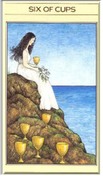
2. From the Mythic Tarot:
The Six of Cups shows up for a heavy-hearted client telling her “it’s better to have loved and lost,” a decidedly different message than most other Tarot decks where the Six of Cups reflects togetherness, companionship, and enjoyment.
3. And this -- to illustrate how the storehouse can work in the other direction, informing us in reverse, as it were:
A client asks about her son, wanting to know what’s ahead for him
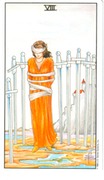
in the next few months. We draw the Eight of Swords from the Rider-Waite Tarot deck, but in my head I keep picturing the Eight of Swords from the Connolly Tarot. (I didn’t do it on purpose, I swear!)
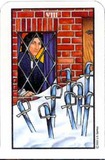
The Connolly Eight of Swords shows a man looking mournfully at a snowy landscape through the bars of what appears to be a jail window. And there it was: the son was in jail, and not apt to be getting out any time soon. Also, the “hit” was that maybe it was good for him to be there, as some things needed to be worked out in his own mind.
So, as if we didn’t have enough to keep track of with all those different images, numbers, elements, astrological associations, and our past history with certain cards, now we have the blessing/curse of hundreds of different Tarot decks through which to sift, absorb, learn, and discern.
We’re lucky to live in a time when there is SOOOO much Tarot information out there and so many tools available to us. We have an embarrassment of riches in this regard. But the massive amount of information can be daunting and the challenge to weed through it all is real. However, it is all worth the effort if you give your attention to the images which are in front of you, maintain your trust in intuition and personal sensibilities, and remember to love the one you’re with.
